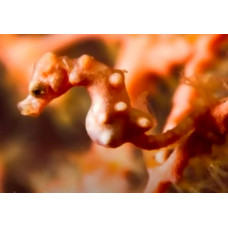Latin name
Hippocampus denise
Other name
Yellow pygmy seahorse
Identification
Denise's pygmy seahorse has a short snout, a slender body and a stout tail. Its body is either completely smooth or has some polypoid tubercles, in which case they are smaller and less developed than in Hippocampus bargibanti.
There are 12 rings on the body and 28-29 on the tail. The body is fleshy, with the inferior and ventral ridges of the trunk reduced to separate, cross-shaped spicules, which grow into the skin. Occipital plate rounded, without convex corolla. Length of snout about 30% of length. Depth of head about 50% of length. There are no spikes above the eye. Depth of trunk (between 9th and 10th cranial ring) about 7% in SL (females) and 10-15% in SL (males).
Features of fish fins
Dorsal soft rays (total): 14.
The anal fin is small or absent.
Fish colouring
The colouration of the Denise's pygmy seahorse ranges from yellow, more or less bright, to orange, often with small dark spots and sometimes darker stripes on the tail.
Distribution
This species is relatively rare and there is little data on the population and its actual distribution. This seahorse has been reported from several locations in the western Pacific, including Indonesia, Palau, Indonesia, Malaysia, Solomon Islands, Vanuatu, Micronesia and Vanuatu.
Habitat
A tropical marine species living on reefs. The depth range is 7-100 m. It can be found at depths of 13-100 m, usually hiding in thickets of Alcyonacea (e.g. Annella, Muricella and Echinogorgia).
Size
It is a small fish, with a maximum length of about 2.4 cm for females and 2.2 cm for males, making it one of the smallest seahorses.
Behavior
Denise's pygmy seahorse uses adaptive camouflage, changing colour to match the surrounding Alcyonacea. Individuals usually remain on the same coral for life. Does not migrate.
Food and feeding habits
This species of seahorse feeds on small crustaceans and other zooplankton.
Reproduction
This species is oviparous and it is the male that carries the eggs in the abdominal brood pouch. It has capillary-rich villi that surround each fertilised egg, forming a kind of placenta that nourishes the embryos. As the fry grow, they are ejected from the pouch and live on their own. Males are known to 'give birth' to 6-7 cubs after 11 days of gestation and experience four consecutive 'pregnancies' of equal duration.
Fishing
Denise's pygmy seahorse is not commercially important in fisheries.
Relationship with a person
Harmless. Is on the list of species that are not necessarily threatened with extinction but whose trade must be controlled to avoid uses incompatible with their survival.
| Classification | |
| Phylum | Chordata |
| Class | Actinopterygii |
| Squad | Syngnathiformes |
| Family | Syngnathidae |
| Genus | Hippocampus |
| Species | H. denise |
| Features | |
| Conservation status | Data deficient |
| Habitat | Pelagic |
| Life span, years | No information |
| Maximum body weight, kg | No information |
| Maximum length, cm | 2,4 |
| Sailing speed, m/s | No information |
| Threat to people | Not edible |
| Way of eating | Planktonophage |
Denise's pygmy seahorse
Tags: denises pygmy seahorse

